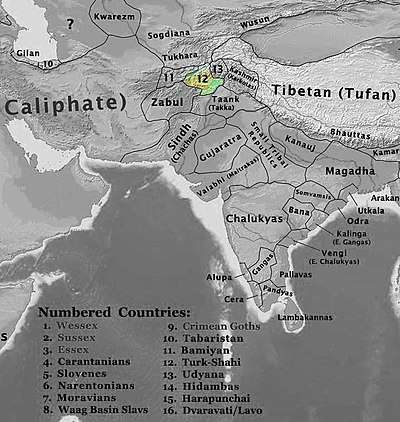Turk Shahi
The Turk Shahi (Turkish: Türk Şahiler) were a Buddhist Turkic dynasty that ruled from Kabul and Kapisa in the 7th to 9th centuries. They replaced the Nezak – the last dynasty of Bactrian rulers with origins among the Xwn (Xionite) and/or Huna peoples (who are sometimes also referred to as "Huns" who invaded Eastern Europe during a similar period).
Turk Shahi | |||||||||||||
|---|---|---|---|---|---|---|---|---|---|---|---|---|---|
| 665–850 | |||||||||||||
 Tamga of the Turk Shahi
| |||||||||||||
 Lands of the Turk Shahi in 700 CE, after the secession of Zabulistan. | |||||||||||||
| Capital | Kabul | ||||||||||||
| Religion | Buddhism | ||||||||||||
| Tegin | |||||||||||||
• 665 - 680 | Barha Tegin | ||||||||||||
• 680 - c. 730 | Khorasan Tegin Shah | ||||||||||||
• ? - c. 850 | Lagaturman | ||||||||||||
| Historical era | Early Middle Ages | ||||||||||||
• Established | 665 | ||||||||||||
• Disestablished | 850 | ||||||||||||
| |||||||||||||
| Today part of | Afghanistan | ||||||||||||
| History of the Turkic peoples pre-14th century |
|---|
History of the Turkic peoples |
| Tiele people |
| Göktürks |
|
| Khazar Khaganate 618–1048 |
| Xueyantuo 628–646 |
| Kangar union 659–750 |
| Turk Shahi 665-850 |
| Türgesh Khaganate 699–766 |
| Kimek confederation 743–1035 |
| Uyghur Khaganate 744–840 |
| Oghuz Yabgu State 750–1055 |
| Karluk Yabgu State 756–940 |
| Kara-Khanid Khanate 840–1212 |
| Ganzhou Uyghur Kingdom 848–1036 |
| Qocho 856–1335 |
| Pecheneg Khanates 860–1091 |
| Ghaznavid Empire 963–1186 |
| Seljuk Empire 1037–1194 |
| Cumania 1067–1239 |
| Khwarazmian Empire 1077–1231 |
| Kerait Khanate 11th century–13th century |
| Delhi Sultanate 1206–1526 |
| Qarlughid Kingdom 1224–1266 |
| Golden Horde 1240s–1502 |
| Mamluk Sultanate (Cairo) 1250–1517 |
Kabulistan was the heartland of the Turk Shahi domain, which at times included Zabulistan[1] and Gandhara.
During their rule, the Turk Shahi were an obstacle to the eastward expansion of the Abbasid Caliphate.
The last Shahi ruler of Kabul, Lagaturman, was deposed by a Brahmin minister, possibly named Vakkadeva,[2][3][4] in c. 850, signaling the end of the Buddhist Turk Shahi dynasty, and the beginning of the Hindu Shahi dynasty of Kabul.[5]
Coinage

_of_the_Nezac_Huns_680-738.jpg) "Sri Shahi", royal title of the Turk Shahi (680-738 CE).[6]
"Sri Shahi", royal title of the Turk Shahi (680-738 CE).[6] Turk Shahi ruler, early 8th century CE.
Turk Shahi ruler, early 8th century CE.
References
- "15. The Rutbils of Zabulistan and the "Emperor of Rome"". Pro.geo.univie.ac.at. Retrieved July 22, 2017.
- D. W. Macdowall, "The Shahis of Kabul and Gandhara" Numismatic Chronicle, Seventh Series, Vol. III, 1968, pp. 189-224, see extracts in R. T. Mohan, AFGHANISTAN REVISITED … Appendix –B, pp. 164-68
- Raizada Harichand Vaid, Gulshane Mohyali, II, pp. 83 and 183-84.
- H. G. Raverty, Tr. Tabaqat-i-Nasiri of Maulana Minhaj-ud-din, Vol. I, p. 82
- "16. The Hindu Shahis in Kabulistan and Gandhara and the Arab conquest". Pro.geo.univie.ac.at. Retrieved July 22, 2017.
- CNG Coins
